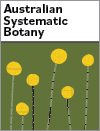Whereas one expects to see different land plants and animals in different places, the ‘everything-is-everywhere’ hypothesis of microbial biogeography, e.g. unicellular algae, tends to become a self-fulfilling prophesy. We found a high proportion of new species in our samples. This is evidence for regional endemicity in marine diatoms, i.e. that the Licmophora flora(s) in eastern Australia and Guam are different from the European floras on which identification is often based.

Australian Systematic Botany
Volume 35 Number 6 2022
A comprehensive review of 60 years of distribution data and taxonomic samples of marine dinophysoid dinoflagellates in Australian waters resolved 64 Ornithocercus taxa, which are illustrated by light and electron microscopy. Selected bloom-forming Dinophysis species are the cause of diarrhetic shellfish poisoning, while tropical genera such as Ornithocercus and Histioneis deserve careful attention in monitoring for southward range expansions. We rediscovered rare tropical species such as Histiophysis rugosa (Kof. & Mich.) Kof. & Skogsb., previously described on the basis of a single specimen only.
SB21023 Abstract | SB21023 Full Text | SB21023PDF (12.3 MB) Open Access Article




